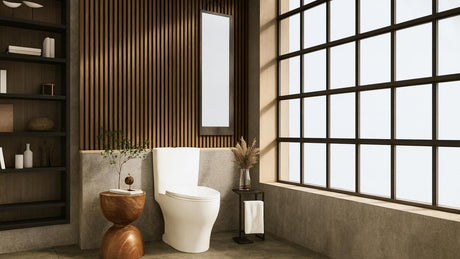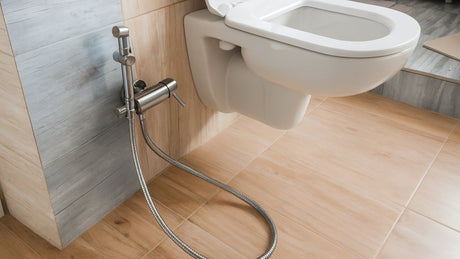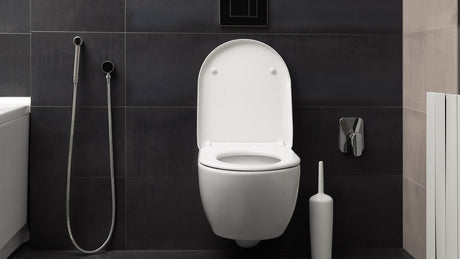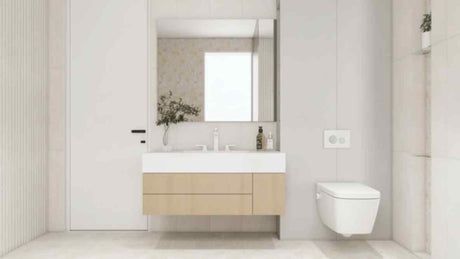A bidet can look a bit confusing at first. Some people think it’s a small sink, while others see it as something fancy they don’t really need. But what is it, really?
This guide explains what a bidet is, its different types, why people use them, and how to use one correctly. By the end, you’ll know if a bidet is a good fit for your home in Australia.

What Is the Bidet and How Does It Work?
What is a bidet toilet? It’s a bathroom fixture designed for personal hygiene after using the toilet. The bidet meaning traces back to France in the 17th century, where it originated as a simple basin for cleansing. If you’ve seen the word “beday” before, it’s just a misspelling of “bidet.” They both mean the same thing.
Today, the bidet uses a stream of water to clean the genital and anal areas, removing residues like stool, urine, or menstrual blood more effectively than toilet paper alone. This hands-free approach minimises direct contact and reduces the spread of bacteria.
Some bidets include warm air dryers for added comfort. Basic bidets use a small nozzle or tap that sprays water upward, or a handheld sprayer you can aim yourself. Advanced electric bidets have buttons or remotes to control water pressure, spray movement, and even self-cleaning nozzles.
Different Types of Bidets
Bidets come in many styles to fit different bathrooms and personal needs:
1. Standalone Bidets
A separate fixture resembling a low sink, installed next to the toilet. Straddle it and use water jets or taps for cleaning. Popular in traditional European bathrooms, offering hot/cold water for thorough cleansing.
2. Bidet Attachments or Seats
These replace or fit under your existing toilet seat. They are easy to install, featuring adjustable nozzles, heated seats, and sometimes air dryers. Perfect for compact spaces and hands-free operation.
3. Handheld Bidets (Shattaf or Bum Gun)
A mini showerhead attached to the toilet's water supply. Users hold the hose to direct the spray while seated. Common in Asia and the Middle East, used for personal cleaning or rinsing the toilet.
4. Integrated or Smart Toilets
Combines toilet and bidet functions in one unit. Features include automatic lids, deodorisers, nightlights, and variable spray patterns. Professional installation is usually required.
Benefits and Drawbacks of Using a Bidet
Benefits:
- Enhanced Hygiene: Provides a thorough clean, reduces bacterial transfer, and is gentle on sensitive skin.
- Health Support: Eases discomfort from constipation or IBD, helps people with disabilities, pregnant women, or the elderly maintain independence.
- Eco-Friendly: Reduces toilet paper use, saving trees.
- Comfort and Convenience: Adjustable sprays, heated seats, and air dryers create a spa-like experience.
Drawbacks:
- Initial Cost: Advanced models can be expensive.
- Space Requirements: Standalone bidets need extra room and plumbing.
- Learning Curve: First-time users may need time to adjust to water cleaning.
- Drying Needs: Not all models have air dryers; towels or toilet paper may still be needed.
How to Use a Bidet?
Step-by-step guide for proper use:
Step 1: Use the toilet as usual
Finish your business first. Optional light wipe with toilet paper before rinsing.
Step 2: Position yourself
- Standalone: Straddle it facing the faucets or away, aligning with the water jet.
- Bidet attachment/seat: Stay seated on the toilet.
- Handheld sprayer: Hold the hose while seated.
- Smart toilet: Use side panel or remote control.
Step 3: Turn on water and adjust settings
Start with low pressure and lukewarm water. Test spray into the bowl first. Direct stream at the area to clean (front to back for females).
Step 4: Cleanse the area
Rinse for 30-60 seconds. Use mild soap with standalone bidets. Avoid overly high pressure to prevent splashing or irritation.
Step 5: Dry off
Use air dryer if available, otherwise pat dry with toilet paper or towel.
Step 6: Clean up and exit
Wipe down bidet or nozzle if necessary, especially in shared spaces. Wash hands thoroughly. Release and hang hose for handheld sprayers.
Can You Install a Bidet Yourself in Australia?
Some bidets can be DIY-installed, like handheld sprayers and toilet seat attachments, connecting to the toilet’s water line with basic tools. Standalone or fully built-in bidets require licensed plumbers due to WaterMark Certification and Australian plumbing rules. Electric or smart toilets may also need an electrician. Professional installation ensures compliance and safety.

MyHomeware offers bidet seats, handheld sprayers, and easy-to-install attachments. From simple to high-end designs, there’s a solution for every home and budget.

Conclusion
Bidets clean with water instead of toilet paper, helping you stay fresh, reduce paper use, and protect the environment. Styles range from simple add-ons to smart toilets with enhanced comfort. Bidets are becoming popular in Australia. Check MyHomeware’s WaterMark-certified bidets for safe, modern, and easy-to-use options.
FAQs
Is a bidet more hygienic than toilet paper alone?
Yes, bidets rinse waste with water, lowering bacteria transfer and skin irritation. They are gentler, ideal for people with hemorrhoids or sensitive skin. Many users still pat dry with toilet paper. Regular cleaning ensures safety and effectiveness.
Is it unsanitary to share a bidet?
No, sharing a bidet is safe if maintained properly. Modern bidets have self-cleaning nozzles. Wiping with mild disinfectant at home is sufficient. In public, wipe the nozzle before use. Personal bidets remain the most hygienic choice.
Do you still have to wipe after using a bidet?
Not always. Many bidets include air dryers for hands-free drying. Some prefer patting with a small piece of toilet paper. Overall, bidets significantly reduce toilet paper usage.
How expensive are bidets?
Prices vary: basic handheld sprayers $50-$100, mid-range attachments/seats $200-$500, premium smart toilets >$1,000 with features like heated seats, dryers, and remotes.








